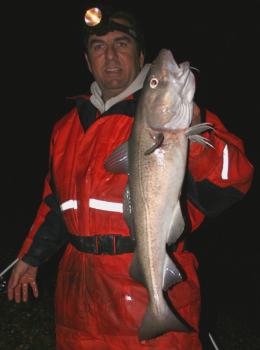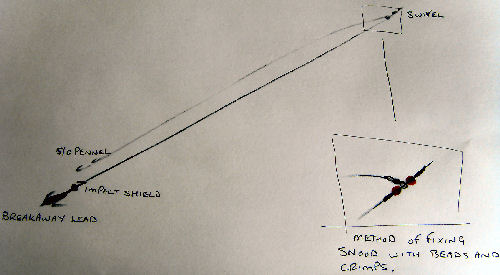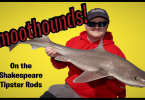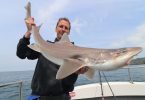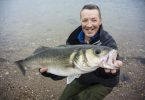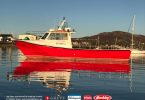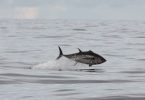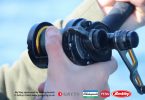“You should have been here yesterday; they were climbing up the beach.” How many times have you heard that as you wander along the beach to see if anyone else has caught anything, after six hours without a bite? At one time, it seemed to me that all beach anglers were liars. There weren’t any cod and the locals were just pretending they’d caught some the night before to wind up a Londoner for a bit of sport. After all, I had all the tackle, the right bait and I was fishing the best beaches. If I couldn’t catch cod, there weren’t any there; it was as simple as that. The truth was, though, there had been cod there and I’d missed them. What you have to remember is, the best tackle in the world won’t guarantee you catch cod, nor will the best bait and nor will the ability to cast 200 yards. If you are in the wrong place, or the right place at the wrong time, you will blank. If, however, you manage to get yourself in the right place at the right time, success is almost guaranteed.
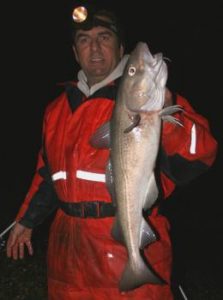 How may anglers fish to the calendar, instead of the conditions? You’d be amazed at the number of people who go fishing every Saturday, or Sunday, or the second Tuesday of every month, from 10 o’clock until 5 o’clock, religiously and regardless of conditions. You see them standing there on the beach in bright sunshine with their line hanging limp in the clear water because there isn’t enough tide to pull a curve into their rod tip. The vast majority of these scheduled trips are unproductive. On the other side of the coin are the successful anglers who don’t fish as often, but who catch far more fish. These anglers are opportunists. They’ll sit at home for weeks if they have to, waiting for conditions to come together before loading up the car and driving to greet the cod as they arrive on the beaches.
How may anglers fish to the calendar, instead of the conditions? You’d be amazed at the number of people who go fishing every Saturday, or Sunday, or the second Tuesday of every month, from 10 o’clock until 5 o’clock, religiously and regardless of conditions. You see them standing there on the beach in bright sunshine with their line hanging limp in the clear water because there isn’t enough tide to pull a curve into their rod tip. The vast majority of these scheduled trips are unproductive. On the other side of the coin are the successful anglers who don’t fish as often, but who catch far more fish. These anglers are opportunists. They’ll sit at home for weeks if they have to, waiting for conditions to come together before loading up the car and driving to greet the cod as they arrive on the beaches.
So what are the right conditions?
Well, the first thing to take into account is the tides. For cod fishing from the beach, you need plenty of tide running. I won’t go into details as to why, you just do. That means fishing on spring tides, so get yourself a tide table and highlight the biggest tides for your trips. Another desirable for cod fishing from the beach, especially if you have to fish in daylight, is colour in the water. Different areas will fish better during, or after, certain weather conditions that have stirred up the sea bed and put a bit of colour in the water. In my area, a North Easterly gale stirs things up nicely. If conditions are too bad to fish, you will have to wait for things to calm down a bit, but if you are there as soon as you are able to hold bottom, you will be giving yourself the best chance of success. These conditions are the only ones that will see me beach fishing for cod during the daytime. If you can’t fish in conditions like that during the day, you will need to fish at night. Cod fishing from the beach should be, almost exclusively, a night time activity. Again, there are reasons why, but I won’t go into them now. So, now we’ve got the right time sorted out, we just need the right place and we’re in business.
As a general rule, the best cod beaches are the ones that give access to deep water close in. The steep shingle beaches of Orford, Aldeburgh and Dungeness are all famous cod beaches, but there are many more beaches with quite different characteristics that can fish equally as well. The thing you need to find out is at what state of tide these beaches fish best and that is where local knowledge and experience comes into play. When I used to travel from London to the coast, I was always under the impression that the best time to fish was three hours either side of high water. Quite often, I would be packing up just as local anglers were arriving. This should have told me something, but I thought they were just mad men. I mean, who in their right mind would fish for cod over low water? Thankfully, I learned my lesson in the end after passing a local angler walking back to his car at Aldeburgh one night, just as I was walking along the beach to start fishing. He was weighed down with a sack of cod that he had caught one hour each side of low water. I also used to think that the flood tide was best, but that isn’t always the case, either. Very often the ebb will out fish the flood because, among other things, the tide pulls stronger on the ebb.
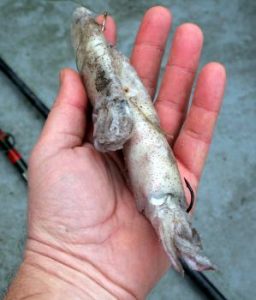 Right, so now we’re in the right place at the right time, we just need to get some cod out of the water and onto the beach. Probably the most important thing, now, is the bait we use. For cod, you need to use a big bait. They have a huge mouth for a good reason and that is, they eat a lot. Like most animals, they want to put as many calories as they can into their body, with the least amount of effort. They will swim lazily with the tide grubbing around for anything that presents itself in front of them. They won’t divert or swim against the tide just to eat two small, washed out lugworms. To increase your chances of catching a cod from the beach, your bait needs to be big and juicy. Some of the worms you buy from tackle shops are so small that you are wasting your time buying them. You need to put 10 or more onto the hook in order to make a half decent cod bait and that just isn’t economically viable. So, unless you know where you can buy proper, cigar sized, lugworm or dig your own, you need to start looking at other baits. By far, the best I’ve found is the unwashed squid that is used by commercial longliners. I fish one or two of these whole on a pennel rig. Whatever bait you use for cod, as a rule of thumb, it needs to be at least half the size of your fist. And don’t forget live bait. Many a big cod has been caught on live pouting or whiting, often those that have taken a small bait meant for the cod that ate them!
Right, so now we’re in the right place at the right time, we just need to get some cod out of the water and onto the beach. Probably the most important thing, now, is the bait we use. For cod, you need to use a big bait. They have a huge mouth for a good reason and that is, they eat a lot. Like most animals, they want to put as many calories as they can into their body, with the least amount of effort. They will swim lazily with the tide grubbing around for anything that presents itself in front of them. They won’t divert or swim against the tide just to eat two small, washed out lugworms. To increase your chances of catching a cod from the beach, your bait needs to be big and juicy. Some of the worms you buy from tackle shops are so small that you are wasting your time buying them. You need to put 10 or more onto the hook in order to make a half decent cod bait and that just isn’t economically viable. So, unless you know where you can buy proper, cigar sized, lugworm or dig your own, you need to start looking at other baits. By far, the best I’ve found is the unwashed squid that is used by commercial longliners. I fish one or two of these whole on a pennel rig. Whatever bait you use for cod, as a rule of thumb, it needs to be at least half the size of your fist. And don’t forget live bait. Many a big cod has been caught on live pouting or whiting, often those that have taken a small bait meant for the cod that ate them!
So, now we know we’ve got to use big baits, how do we get it out to where the cod are? The first thing to do is mount it on hooks that are big enough to hold the bait without the points becoming masked. The hook also needs to be big enough to actually touch the sides of a cod’s mouth as it swims off with your bait. I use 5/0’s, which are just about big enough. A simple paternoster rig is all you need to present it (see diagram below). Sometimes, when fishing some of the shallower beach marks, it is important to get your bait out as far as possible. I used to practice sophisticated casting techniques and use highly tuned reels to achieve the required distance. I also used to suffer a lot of crack-offs and backlash. There are anglers out there who can reproduce a flawless pendulum cast on a steeply shelving beach and launch a whole squid bait into a stiff onshore breeze, time after time, but I’m not one of them. Usually, excitement, mixed with a bit too much caution, would see my first cast crack off and then I’d spend the rest of the session casting like a pansy, just in case I cracked off again. Thankfully, there is a far easier alternative available now. Long rods and good fixed spool reels. You might not look as flash in front of your mates, but you will be able to hoof a big bait out to the required distance with little effort, not much technique, and a lot of consistency. You don’t have to spend a fortune, either. I use a 14ft Shakespeare K2 Blue Metal matched with one of their middle range fixed spool reels. I still use my Conoflex and Abu 6500, but only when conditions are right will I really wind them up and, even then, only when I’ve got the Shakespeare outfit as a back up should things get ugly.
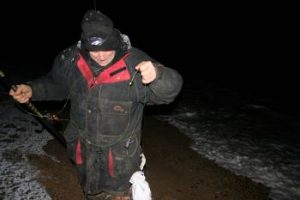 Now all the hard work has been done, the only thing left to do now is get fishing. There are one or two things you can do to improve your chances further and to make the whole experience more enjoyable, though. Cod seem to run along the beaches in waves, which is why you often get long periods of complete inactivity followed by several bites in quick succession. If you can, avoid busy times like Friday and Saturday nights. Often, when the cod are in, the popular beaches will be packed at weekends. That means whatever fish run along that part of the beach will have run a gauntlet of baited hooks before they reach yours. A proportion of them will be caught, which decreases your chances of success. If you hit the beach during the week, when there are few anglers, the odds of success will be stacked even more in your favour. You also need to make sure you are warm and comfortable to make the most of your session. Flotation suits are excellent for keeping out the cold, wind and rain, and a well positioned beach shelter makes even the worst weather conditions bearable. Get a good, reliable paraffin lamp, and/or a decent headlamp. Take plenty of food and something hot to drink. (Paraffin lamps are good for heating up pies). Once you are sorted out and your baits are in the water, if you’ve got everything right, the feeling of anticipation will be electric. It should only be a matter of time before the rod tip bounces as a cod moves off with you hook firmly embedded in its mouth. Pick the rod up and wind in any slack line, then feel the solid thump, thump out in the blackness as your cod shakes his head. Keep a tig
Now all the hard work has been done, the only thing left to do now is get fishing. There are one or two things you can do to improve your chances further and to make the whole experience more enjoyable, though. Cod seem to run along the beaches in waves, which is why you often get long periods of complete inactivity followed by several bites in quick succession. If you can, avoid busy times like Friday and Saturday nights. Often, when the cod are in, the popular beaches will be packed at weekends. That means whatever fish run along that part of the beach will have run a gauntlet of baited hooks before they reach yours. A proportion of them will be caught, which decreases your chances of success. If you hit the beach during the week, when there are few anglers, the odds of success will be stacked even more in your favour. You also need to make sure you are warm and comfortable to make the most of your session. Flotation suits are excellent for keeping out the cold, wind and rain, and a well positioned beach shelter makes even the worst weather conditions bearable. Get a good, reliable paraffin lamp, and/or a decent headlamp. Take plenty of food and something hot to drink. (Paraffin lamps are good for heating up pies). Once you are sorted out and your baits are in the water, if you’ve got everything right, the feeling of anticipation will be electric. It should only be a matter of time before the rod tip bounces as a cod moves off with you hook firmly embedded in its mouth. Pick the rod up and wind in any slack line, then feel the solid thump, thump out in the blackness as your cod shakes his head. Keep a tig
ht line and pay particular attention when the fish is close in. The undertow from the waves and any last ditch attempts to get it’s head down make this the time when you are most likely to lose your cod. When the fish is in the surf, walk backwards to drag it up onto the shingle. There is no sight quite like the sight of a cod flapping and glistening on the shingle in the light from your head lamp, as you walk back down to the waters edge to pick it up. There is no experience quite like cod fishing from the beach. Go out there and have some.
Steve Coppolo, September 2009
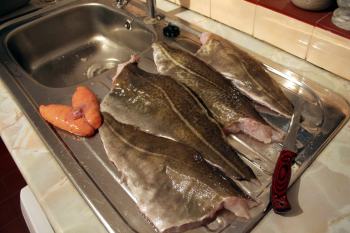 Get it right and you’ll be having cod for tea!
Get it right and you’ll be having cod for tea!

